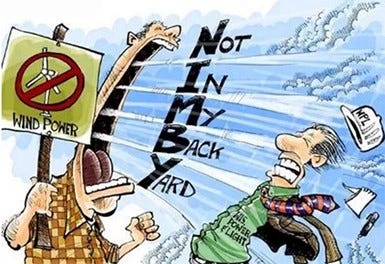What Does It Mean to have a Just Transition?
In this week's post, we discuss the concept of a "Just Transition" and break down the challenges renewables face.
What is the Energy Transition?
There is a scientific consensus that in order to prevent the worst damages from climate change, we need to limit the global temperature increase in this century to 2 degrees[1]. This means that global net emissions of greenhouse gases need to fall by about 45% from 2010 levels by 2030, reaching net zero emissions around 2050[2].
In order to mitigate the effects of climate change, we will need to undergo what is called the “energy transition”. This refers to the ongoing process of replacing fossil fuels with renewable or low-carbon energy sources.
There are many challenges we are facing with regards to the energy transition. One is the human impact of energy security (or lack thereof). Energy security is a term that describes uninterrupted access to affordable energy. Energy security is not a guarantee in developing countries[3] and areas of conflict within developed countries[4]. Climate change further exacerbates the impact of energy insecurity, with heatwaves and freezes putting stress on existing energy infrastructure and increasing the severity of the consequences of an outage (such as a hospital losing power).
Another challenge faced is lack of consensus. We don’t know about y’all, but even within our circle of family friends, there are people who deny that climate change is happening. So that’s the first hurdle: accepting that the climate is changing. Next, it is hard to get a consensus on the urgency of climate change. Most scientists (and countries who has signed on to the Paris Agreement) agree that it is critical to reach net zero by 2050. However, two of the world’s largest emitters (China and India) have net zero goals by 2060 and 2070 (respectively).
Finally, a challenge is the investment and length of time it takes to scale renewable technologies. We will explore this next.
Why Can’t We Just Switch to Renewables Now?
Currently, only 12% of our energy consumption comes from true renewables, primarily from solar, wind, and hydroelectric. Another 8% comes from another low/no emission power source: nuclear. So why are these numbers so low?
Disadvantages of Solar & Wind: Base Load vs. Intermittent Load
To level set here – “load” is the total amount of electricity being consumed by users of the grid. Base load power is important because it is reliable. This type of power is typically provided by coal and natural gas. Base load power is supplemented by intermittent power, provided by sources that produce energy intermittently. One of the main challenges with the main sources of renewable energy today (solar and wind) is that these sources of energy are intermittent. Weather is hard to predict - the sun doesn’t always shine, the wind doesn’t always blow.
For countries in Europe that have been quicker to adopt renewables, this posed a significant challenge during last year’s “light wind summer”. Wind speeds were milder, which resulted in a reliance on natural gas to make up the difference. This resulted in Europe paying record prices for natural gas and a dramatic increase consumer electricity prices[5].
Source: Reuters
Additional disadvantages that we won’t go too deep into here are the lifecycle management issues surrounding wind and solar. For solar – there are issues related to mining the materials required to create solar panels (see our post on gold) and issues related to the disposal of solar panels at the end of their useful life. For wind, the issues primarily involve end-of-life management. Since wind turbine blades are built to withstand extreme weather, they can’t be easily recycled or repurposed. This means they will build up in landfills over the years.
Hydropower Disadvantages: Environmental and Social Issues
Okay, so what if wind and solar are unreliable? There are other sources of renewable energy like hydropower and nuclear. While water is technically renewable, hydropower can environmental and social problems. Dams often have negative environmental and social impacts both upstream and downstream through their construction. In order to build a dam, roads and power lines have to be installed, which can displace both species and local communities.
Typically, we think of renewable energy sources as not emitting greenhouse gases. However, dams also form reservoirs that can drastically change the landscape and rivers they are built on. When a dam floods an area, it creates stagnant water that kills vegetation which emits greenhouse gasses as it rots.
Finally, hydropower has associated safety concerns. Construction accidents, as well as dam failure, can cause injuries or even death. For example – there were 96 deaths that were officially recorded during the construction of the Hoover Dam. These were men who died at the dam site from such causes as drowning, blasting, falling rocks or slides, falls from the canyon walls, being struck by heavy equipment, truck accidents, etc[6].
Nuclear Disadvantages: Long Ramp Up Time & Expensive – Plus Risk of Catastrophe
Source: Political Dictionary – “NIMBY”
Because nuclear power involves the use of hazardous materials, it can be hard to find a location for a plant (most people don’t want a nuclear power plant in their backyard) and the permitting process can be lengthy. Once a location is identified and a permit is granted, it still takes an average of 14 years to build a nuclear power plant. This means that even though nuclear power produces no greenhouse gas emissions, it will take a long time to ramp up.
While nuclear power plants can be cost-competitive with other forms of power generation, nuclear power plants are extremely expensive to build. Companies that are planning new nuclear units indicate that the total building costs (including escalation and financing costs) can be between $6 billion and $9 billion[7]. According to the World Nuclear Association, “Fuel costs for nuclear plants are a minor proportion of total generating costs, though capital costs are greater than those for coal-fired plants and much greater than those for gas-fired plants”[8].
Finally – an issue with nuclear is the significant risk in the case of a failure. While failures are incredibly unlikely due to the sheer amount of infrastructure and controls in place, a single failure could be catastrophic. Unlike most energy sources where the risk to human life is limited to the safety of those working at the site of generation, nuclear fallout can have severe, widespread, and multigenerational impacts (think Chernobyl).
Inflationary Impacts
One of the challenges with switching to renewables is the higher cost and volatility of renewable energy. People (ourselves included) hate feeling like they are overpaying for something. If you’ve ever had a roommate, think about a time that the energy bill was more than you expected. Did you turn on each other and blame each other for keeping the lights or heat on for too long? Were you frustrated? Now think about how the average person would feel about rising prices, even if their energy use stays the same or goes down.
To date, renewables have been viable because of the base of fossil fuel generation that supplies 80% of our electricity needs and also stands in for intermittent wind and solar. As we switch to using more renewables, especially intermittent power sources like wind and solar, our energy sources become more costly and unreliable. The case study we outlined earlier about the “light wind” summer in Europe is a great example.
That’s just in the short term though. Moving to a Net Zero future is going to require massive spending to move past using fossil fuels for baseload and balancing electricity. The International Energy Agency estimates that it will require almost $4T of investment annually to reach Net Zero by 2050 - $2.7T of which will need to come from private developers, consumers, and investors[9]. While the economic and human costs of unabated climate change will be far higher, it is challenging to even get a consensus on the urgency of climate change, let alone convince the average consumer to pay more for energy.
What Does it Mean to Have a Just Transition?
One theme that we have started hearing more and more is this concept of the “Just Transition”. At the highest level, a just transition aims to balance the transition to low carbon energy sources with social themes like economic development and energy security.
That sounds great and all, but how do we achieve this?
1. Be Patient…And Persistent: The consensus among thought leaders in the space is that the energy transition will take a long time. The energy sector won’t be overhauled overnight, instead it will take many decades.
2. Invest in Progress, Not the Idea of Perfection: It will be a process that requires a series of bridges - technology solutions and operational efficiencies will be necessary reduce emissions from fossil fuel combustion. We will need to bridge from coal to relatively cleaner natural gas to nuclear to support the base load as we expand intermittent renewable sources like solar and wind.
3. Collaborate: The energy transition will require collaboration both globally and domestically, between companies, communities, and regulators. According to the Just Transition Alliance, the practice of just transition means that the people who are most affected by climate change (“the frontline workers and the fenceline communities”) should be driving policy solutions.
Hot Tea
Hong Kong Exchange Launches New International Carbon Market Place
COP27: What you need to know about this year’s big UN Climate Conference
Sustainability Movers & Shakers….or Not?
Making headlines over the past couple of weeks was a very vocal campaign called “Just Stop Oil” where protesters threw soups at one of the most famous paintings done by Vincent Van Gogh. This form of activism drew attention around the globe to the pressing issue of climate change.
We are turning to our subscribers this week to get your view on the matter. Do you think this form of activism is effective or do you think there are better ways to draw attention?

Sources
[1] https://www.un.org/en/climatechange/paris-agreement
[2] https://netzeroclimate.org/what-is-net-zero/
[3] Developing Countries: While hard to imagine, there are countries today where people do not have access to reliable electricity. This has implications for access to running water, food preparation, communication, economic development, and human health in those countries.
[4] Areas of Conflict: Besides the death toll and destruction of assets, Russia’s invasion of Ukraine has unsettled global energy markets. It has interrupted the flow of oil and gas to European countries as a result of imposed sanctions on Russia. The price of crude oil has increased from an average of $68 per barrel in 2021 to as high as $124 in 2022. Volatility in the supply of energy in Europe has resulted in high consumer prices and raised a question of whether or not the lights would turn on when you flip the switch.
[8]https://world-nuclear.org/information-library/economic-aspects/economics-of-nuclear-power.aspx
[9] https://www.iea.org/articles/the-cost-of-capital-in-clean-energy-transitions









